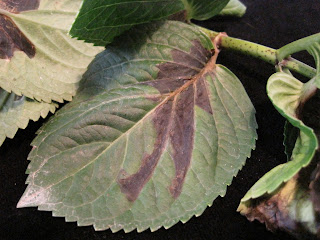 |
| Bacterial spot lesions on hydrangea (Photo: Mike Munster) |
 |
| Water-soaked lesions (Photo: Mike Munster) |
 |
| Stem lesions (Photo: Mike Munster) |
To identify the bacteria responsible for causing the leaf spots in these cases, we had to culture them and then perform additional assays. These assays identify bacteria based on their ability to metabolize different kinds of nutrients and compare the results with a database. Results identified the culprit as an Acidovorax sp. We then took this bacteria and inoculated a healthy leaf to make sure the same symptoms were produced.
 |
| Inoculated leaf (Photo: Mike Munster) |
Management recommendations for Acidovorax are similar to those we discussed last week for Xanthomonas. Always start with disease free stock or cuttings. Plants with these symptoms should be removed and destroyed, including the planting mix. Healthy-looking plants adjacent to the diseased plants should be quarantined if possible. Acidovorax is found on petunias, verbena, geranium, hydrangea, and lantana. Greenhouse operators should be sure to inspect all plants in this group if Acidovorax is found.
 |
| Leaf spot symptoms on verbena (Photo: Mike Munster) |
 |
| Leaf spot symptoms on petunia (Photo: Mike Munster) |
Thoroughly clean and then sanitize pots, flats, surfaces, and tools with steam or chemical disinfectants. There are no effective chemical controls for application directly to the plants, but during propagation copper products can be used to hold back the bacteria somewhat.
